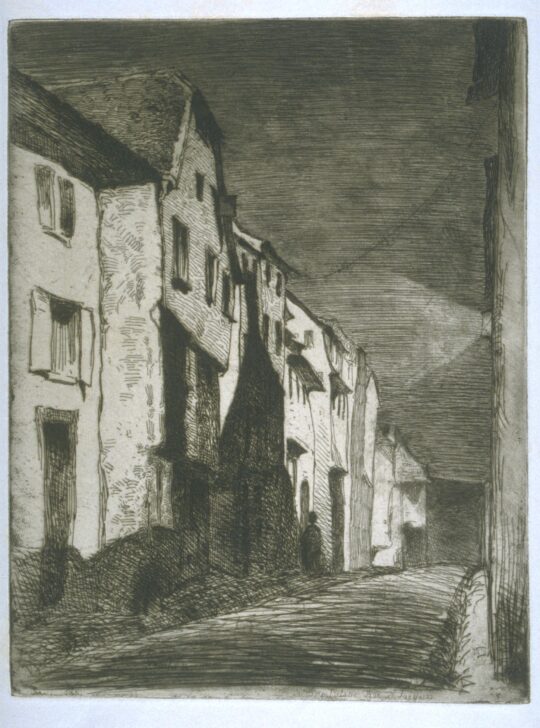Street at Saverne, One of the ‘Twelve Etchings from Nature,’ or the ‘French Set’
James Abbott McNeill Whistler

Description
March 28, 2009
Following his introduction to printmaking with the U.S. Coast and Geodetic Survey and then a deeply rewarding study of etching with his British brother-in-law, Seymour Haden, Whistler traveled to France for formal art training in Paris. In the summer of 1858, Whistler and fellow student Ernest Delannoy made a walking tour through eastern France, Luxembourg, and the Netherlands, producing sketches that were translated into etchings upon their return to Paris. The influence of both seventeenth-century Dutch art (which they saw in Amsterdam) and contemporary French Realism, each of which emphasized naturalism and everyday subjects, may be seen in this view of a street. Whistler’s quotidian scene captures the receding lane and deep shadows that define the faces of the buildings and windows—all described with dark parallel lines. Some years later, Whistler decried the direct approach taken in this print; it must have been anathema to an artistic personality so naturally inclined towards subtlety. As he matured Whistler’s work evolved away from the tenets of Realism and achieved a kind of nuanced understatement that was unrivaled by his contemporaries.
Subject Matter:
Street at Saverne is one of the French Set etchings that is based on a watercolor executed during the walking trip that Whistler and Ernest Delannoy made in the summer of 1858. Night views, known as "Nocturnes", became one of Whistler's signature forms and dominate his views along the Thames during the 1870s as well as views in Venice and Amsterdam in the 1880s. The watercolor on which this etching is based is, in fact, a daytime view of Saverne; when making the print Whistler transformed this into a night view, thus becoming his first nocturne.
Physical Description:
In this nighttime view down a street, buildings along the left-hand side of the street are shown in sharp recession. A solitary figure is seen in the shadows on the left-hand side half way down the street. The sky is darkened with parallel horizontal hatching lines. The only source of light is a lantern on the wall of the right side of the street. Dark shadows fall across the buildings on the left side.
Usage Rights:
If you are interested in using an image for a publication, please visit https://umma.umich.edu/request-image/ for more information and to fill out the online Image Rights and Reproductions Request Form.